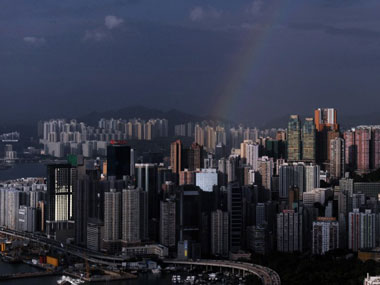When China’s property market catches a cold, the whole world sneezes.
Central banks in the US, Europe and Japan are flooding emerging markets with cheap money, sending stocks to all time high levels, and assets to assume prices that are not in line with their fundamentals. Property, currency and stock markets in Asia are booming, but this easy availability of liquidity has once again brought to shore fears of a 1997-like financial crisis.
According to global real estate consultancy Knight Frank, property prices in Hong Kong rose 23.6 percent in 12 month, the highest in the world. And even though the government is actively trying to cool down the prices, the prices continue to rise.
Contrary to popular belief, this bubble is caused due to spur in private consumption which has been financed by debt, argue noted columnist s CP Chandrasekhar and Jayati Ghosh in the Hindu Business Line today.
[caption id=“attachment_822041” align=“alignleft” width=“380”] Reuters[/caption]
Chandrasekhar and Ghosh believe that growth in Asian economies, especially China is fundamentally dependent on domestic demand, but the sources of the expansion are fragile. They suggest that several East Asian economies now look similar to the US before the Lehman Brothers crisis in September 2008.
Citing housing data from global property guide, they said residential prices in several Asian economies, especially Hong Kong where house prices are inflated due to non-resident purchases by mainland Chinese as well as foreign investors, soared dramatically for at least two years but these prices do not reflect the internal factors that are shaping real estate markets elsewhere in the East Asia region which are showing signs of a slowdown.
For instance regions such as Taipei China, Malaysia and even Indonesia, house prices have tapered off or have even begun declining. In Shanghai and Singapore too the increase in house prices have been less than the general rate of inflation.
The article further points out that in regions like Hong Kong, where property prices have increased manifold, the level of credit to the private sector, and also household debt has increased rapidly. “Private credit to GDP ratios in excess of 100 percent, which has usually meant an inevitable day of reckoning at some point, usually with unpleasant implications,” the article said.
Previous financial crises, such as the 1997-8 Asian financial crash and 2007-9 global financial crash, both witnessed unsustainable property price appreciation as one of the reasons behind the financial mess.
So is this a bubble waiting to burst?
“Indeed, some are already in the process of bursting. Debt levels across the economy are rising beyond the ability of the various debtors to service them. Housing debt is just one of the problem areas. In the case of other forms of personal debt - such as credit card debt, debt to finance purchases of vehicles and student debt - there are similar and growing concerns about the capacity of borrowers to repay,” the article said.
Hence, the most dire predictions see the bubble bursting, causing Asia’s financial system to collapse and to spill over into the global financial system, and again cause a collapse.


)
)
)
)
)
)
)
)
)



